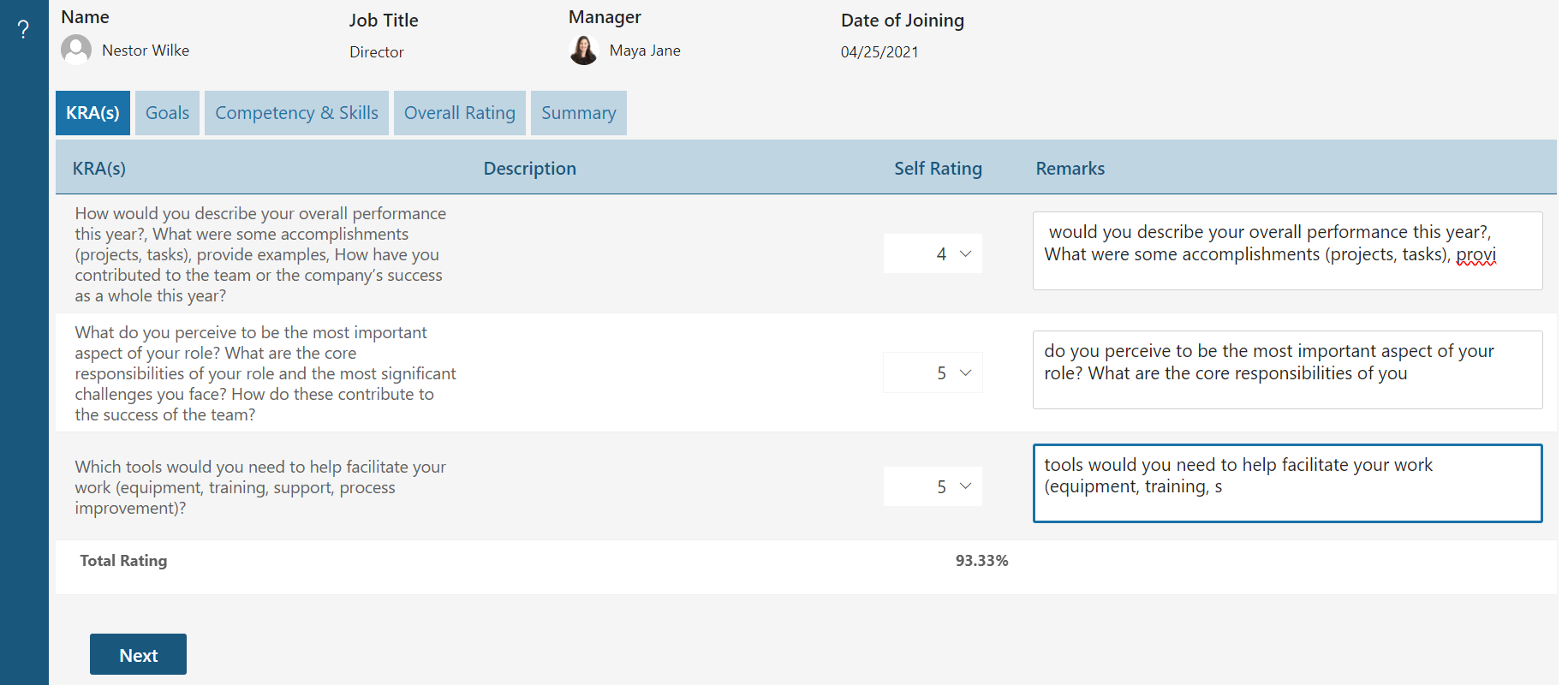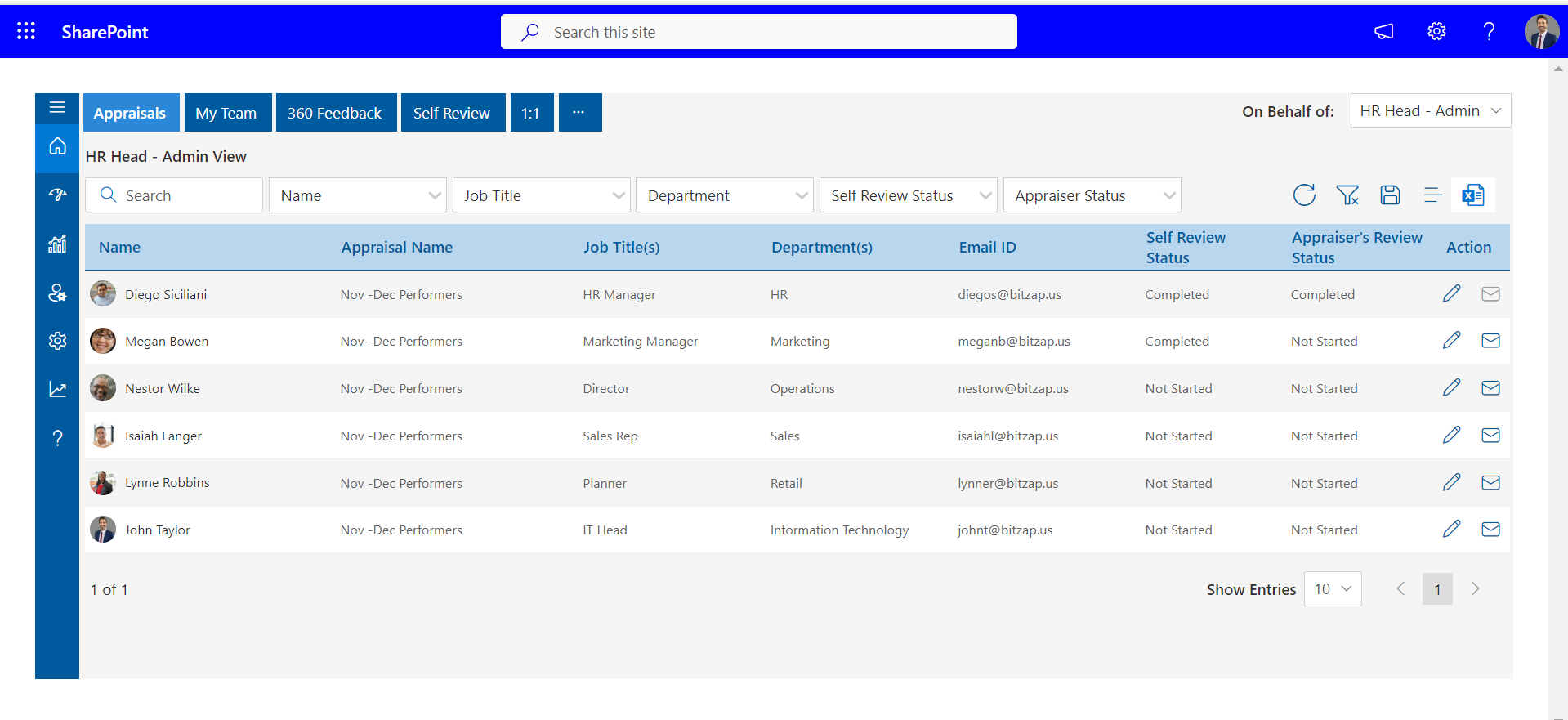Employee Performance Software
Employee performance software is a powerful tool designed to streamline, automate, and optimize the process of managing, evaluating, and improving employee performance within organizations.
Introduction to Employee Performance Software
Employee performance software emerges as a comprehensive solution, offering streamlined processes, data-driven insights, and actionable feedback mechanisms.
By harnessing the power of technology, this software facilitates performance evaluation, goal setting, feedback management, and employee development, ultimately fostering a culture of continuous improvement and maximizing organizational success.
Importance of Employee Performance Management
Employee performance management is a critical aspect of organizational success, playing a pivotal role in driving productivity, engagement, and growth.
Here are some key reasons highlighting its significance:
- Alignment with Organizational Goals: Effective performance management ensures that individual employee goals are aligned with the broader objectives of the organization. By setting clear expectations and targets, employees understand how their work contributes to the overall success of the company, fostering a sense of purpose and direction.
- Enhancing Employee Engagement: Regular performance feedback and recognition are essential for keeping employees motivated and engaged. When employees receive constructive feedback and acknowledgment for their contributions, they feel valued and committed to their work, leading to higher levels of job satisfaction and retention.
- Identifying Strengths and Areas for Improvement: Performance management processes, such as performance appraisals and evaluations, provide valuable insights into employee strengths, weaknesses, and areas for development. This information enables managers to tailor training and development initiatives to address skill gaps and maximize individual and team performance.
- Facilitating Communication and Collaboration: Performance management encourages open and transparent communication between managers and employees. Regular check-ins, goal-setting discussions, and feedback sessions create opportunities for dialogue and collaboration, fostering a culture of trust and accountability within the organization.
- Driving Continuous Improvement: Continuous performance management allows for ongoing monitoring and adjustment of goals and objectives based on changing business needs and individual performance. By fostering a culture of continuous learning and improvement, organizations can adapt to evolving market conditions and stay ahead of the competition.
- Supporting Decision-Making and Talent Management: Performance data collected through performance management systems provides valuable insights for making informed decisions related to promotions, compensation, and talent development. By identifying high-performing employees and potential future leaders, organizations can strategically invest in their talent pipeline and succession planning efforts.
By prioritizing effective performance management practices, organizations can create a culture of excellence and achieve sustainable growth in today’s competitive business landscape.
Key Features of Employee Performance Software
Employee performance software is designed to streamline and enhance various aspects of performance management within organizations. Here are some key features commonly found in such software:
Goal Setting and Alignment:
Employee performance software allows managers and employees to set SMART (Specific, Measurable, Achievable, Relevant, Time-bound) goals aligned with organizational objectives. It enables tracking progress towards these goals and ensures alignment with broader company priorities.
360-Degree Feedback:
Many employee performance software solutions offer 360-degree feedback capabilities, allowing employees to receive feedback from peers, subordinates, and other stakeholders. This comprehensive feedback mechanism provides a well-rounded view of an employee’s performance.
Performance Analytics and Reporting:
Employee performance software generates customizable reports and dashboards that provide insights into individual and team performance metrics. It enables managers to identify trends, strengths, areas for improvement, and training needs based on data-driven analysis.
Performance Improvement Plans :
In cases where employees are not meeting performance expectations, SharePoint performance management software helps create and track performance improvement plans (PIPs). It outlines specific actions, timelines, and milestones for improving performance and achieving desired outcomes.
Integration with HR Systems :
Employee performance management software seamlessly integrates with other HR systems, such as payroll, time tracking, and talent management platforms. This integration ensures data consistency, eliminates manual data entry, and enhances overall HR efficiency.
Security and Compliance:
Employee performance software prioritizes data security and compliance with privacy regulations. It implements robust security measures to protect sensitive employee information and ensures compliance with data protection laws, such as GDPR or CCPA.
With these features, companies may efficiently monitor performance, grow people, and accomplish their strategic goals by utilizing these essential elements.
Selecting the Right Employee Performance Software
Choosing the best performance management software is a crucial decision for any organization looking to optimize its performance management processes.
Here are some key considerations to guide you in selecting the right software solution:
- Assess Your Organization’s Needs: Before beginning your search, evaluate your organization’s specific requirements and objectives for performance management. Consider factors such as the size of your workforce, the complexity of your performance evaluation process, and any unique challenges or goals you may have.
- Define Key Features and Functionality: Identify the essential features and functionality you need in an employee performance tracking software solution. This may include performance appraisal tools, goal setting, and tracking capabilities, feedback and recognition mechanisms, analytics and reporting features, integration with other HR systems, and mobile accessibility.
- Consider User Experience and Ease of Use: Choose a software solution that offers a user-friendly interface and intuitive navigation. Employees and managers should be able to easily access and navigate the system without requiring extensive training or technical expertise.
- Ensure Compatibility and Integration: Verify that the employee performance software integrates seamlessly with your existing HRIS (Human Resources Information System) or other relevant software applications. This will help streamline data management and ensure consistency across different HR processes.
- Evaluate Customization Options: Look for a software solution that allows for customization to align with your organization’s unique performance management processes and terminology. The ability to configure workflows, templates, and evaluation criteria according to your specific requirements is essential for maximizing the software’s effectiveness.
- Assess Scalability and Flexibility: Choose a software solution that can scale and adapt to accommodate your organization’s growth and evolving needs over time. Whether you have a small team or a large enterprise, the software should be able to accommodate changes in workforce size, structure, and performance management practices.
- Consider Security and Compliance: Data security and compliance with relevant regulations (such as GDPR or HIPAA) are critical considerations when selecting employee performance software. Ensure that the software provider follows industry best practices for data protection and offers robust security measures to safeguard sensitive employee information.
- Evaluate Vendor Reputation and Support: Research the reputation and track record of the software vendor, including customer reviews, testimonials, and references from other organizations. Additionally, consider the level of customer support and ongoing maintenance provided by the vendor to ensure prompt assistance and resolution of any issues that may arise.
By carefully considering these factors and conducting thorough research and evaluation, you can select the right Microsoft performance management software that aligns with your organization’s goals, enhances your performance management processes, and drives business success.
Employee Performance Metrics and KPIs
Employee performance metrics and Key Performance Indicators (KPIs) are essential tools for assessing the effectiveness and productivity of employees within an organization. By tracking specific metrics and KPIs, employers can gain valuable insights into individual and team performance, identify areas for improvement, and make informed decisions to drive organizational success.
Here are some common employee performance metrics and KPIs:
1. Productivity Metrics:
- Output or Production Volume: Measures the quantity of work completed by an employee within a specific timeframe.
- Efficiency: Evaluates how effectively employees utilize resources to accomplish tasks and achieve goals.
- Time Management: Tracks the amount of time spent on different activities or projects to identify areas of inefficiency or opportunities for optimization.
2. Quality Metrics:
- Accuracy: Assesses the level of accuracy and precision in completing tasks or delivering outputs.
- Error Rate: Measures the frequency of errors or mistakes made by employees in their work.
- Customer Satisfaction: Gauges customer satisfaction levels through feedback surveys or ratings, reflecting the quality of products or services delivered by employees.
3. Goal Achievement:
- Goal Attainment: Measures the extent to which employees achieve their individual or team goals and objectives.
- Goal Alignment: Evaluates the alignment between employee goals and organizational objectives to ensure strategic alignment and focus.
4. Performance Reviews and Feedback:
- Performance Ratings: Quantifies employee performance based on performance evaluations conducted by managers or peers.
- Feedback Frequency and Quality: Tracks the frequency and quality of feedback provided to employees, promoting continuous improvement and development.
5. Employee Engagement and Satisfaction:
- Employee Engagement Scores: Measures the level of employee engagement and commitment to their work and the organization.
- Employee Satisfaction Surveys: Assess employee satisfaction with various aspects of their job, including compensation, work environment, and opportunities for growth and development.
6. Attendance and Punctuality:
- Attendance Rate: Calculates the percentage of time employees are present and available for work.
- Punctuality: Measures the timeliness of employees in arriving to work and adhering to scheduled shifts or meetings.
7. Training and Development:
- Training Completion Rates: Tracks the percentage of employees who successfully complete training programs or courses.
- Skill Development: Assesses the acquisition and improvement of job-related skills and competencies over time.
8. Employee Turnover and Retention:
- Turnover Rate: Calculates the percentage of employees who leave the organization within a specified period.
- Retention Rate: Measures the percentage of employees who remain with the organization over a given timeframe.
It’s important for organizations to carefully select and customize performance metrics and KPIs based on their unique business objectives, industry, and organizational culture. Additionally, regular monitoring and analysis of these metrics can help organizations identify trends, patterns, and areas for improvement, enabling them to implement targeted interventions and initiatives to enhance employee performance and drive organizational success.
ROI and Benefits of Employee Performance Software
Employee performance software offers a range of benefits to organizations, helping them improve productivity, engagement, and overall performance. Understanding the return on investment (ROI) associated with implementing such software is crucial for decision-makers.
Here are some key benefits and considerations related to the ROI of employee performance software:
- Enhanced Productivity: SharePoint performance management software streamlines performance management processes, such as goal setting, feedback collection, and performance appraisal. By automating routine tasks and providing real-time performance data, employees can focus more on their core responsibilities, leading to increased productivity across the organization.
- Improved Employee Engagement: Regular feedback, recognition, and goal alignment facilitated by performance software contribute to higher levels of employee engagement. Engaged employees are more motivated, committed, and invested in their work, leading to reduced turnover rates and higher levels of job satisfaction.
- Greater Transparency and Accountability: Performance software fosters transparency by providing employees with visibility into their performance metrics, goals, and expectations. This transparency promotes accountability as employees take ownership of their performance and strive to meet or exceed expectations set by themselves and their managers.
- Data-driven decision-making: Performance software collects and analyzes data on employee performance, enabling managers to make informed decisions about talent management, training, and development initiatives. By leveraging data insights, organizations can identify trends, strengths, and areas for improvement, leading to more effective resource allocation and strategic planning.
- Continuous Performance Improvement: Employee performance software supports a culture of continuous improvement by facilitating ongoing performance discussions, coaching, and development opportunities. Managers can provide timely feedback and guidance to help employees grow and develop their skills, ultimately contributing to organizational success.
- Cost Savings: While there are initial investments associated with implementing employee performance software, long-term cost savings can be significant. By automating manual processes, reducing administrative burden, and improving employee productivity and retention, organizations can realize substantial cost savings over time.
- Alignment with Organizational Goals: Performance software helps align individual employee goals with broader organizational objectives, ensuring that everyone is working towards common strategic priorities. This alignment enhances organizational agility and resilience, enabling the organization to adapt quickly to changing market conditions and competitive pressures.
- Compliance and Risk Management: Performance software can help organizations ensure compliance with regulatory requirements and mitigate risks related to performance management processes. By maintaining accurate performance records, tracking compliance with policies and procedures, and documenting performance-related discussions, organizations can reduce legal and reputational risks.
By quantifying the tangible and intangible benefits of implementing performance software, organizations can make informed decisions and maximize the value derived from their investment.
Successful Implementation of Employee Performance Software
Implementing employee performance software requires careful planning, effective execution, and ongoing commitment to ensure its successful adoption and integration within an organization.
Here are the key steps and considerations for a successful implementation:
- Needs Assessment and Goal Setting: Begin by conducting a comprehensive needs assessment to identify the specific requirements and objectives for implementing employee performance software within your organization. Define clear goals and success criteria that align with your organization’s strategic priorities and performance management objectives.
- Vendor Selection: Research and evaluate employee performance software vendors based on factors such as features and functionality, compatibility with your existing systems, vendor reputation, customer support, and total cost of ownership. Choose a vendor that offers a solution tailored to your organization’s needs and provides reliable support throughout the implementation process.
- Stakeholder Engagement and Communication: Engage key stakeholders, including executives, managers, HR professionals, and end-users, early in the implementation process. Communicate the benefits of the software, solicit feedback, and address any concerns or questions to gain buy-in and ensure alignment with organizational goals.
- Customization and Configuration: Work closely with the software vendor to customize and configure the employee performance software to meet your organization’s unique requirements and processes. This may include setting up performance review templates, defining evaluation criteria, and configuring workflows and notifications.
- Data Migration and Integration: Plan and execute the migration of relevant data from existing systems to the employee performance software. Ensure seamless integration with other HR systems, such as the HRIS (Human Resources Information System), payroll, and learning management systems, to facilitate data sharing and streamline processes.
- Pilot Testing and Feedback: Conduct a pilot test of the employee performance software with a small group of users to identify any issues or areas for improvement before full-scale implementation. Gather feedback from pilot users to refine processes, address usability issues, and make necessary adjustments to enhance user experience.
- Performance Monitoring and Evaluation: Continuously monitor and evaluate the performance of the employee performance software against predefined goals and success criteria. Track key metrics such as user adoption rates, completion rates for performance reviews, and user satisfaction to assess the effectiveness of the software and identify areas for improvement.
- Continuous Improvement and Optimization: Regularly review and optimize your employee performance software implementation based on feedback from users and evolving organizational needs: leverage software updates and new features provided by the vendor to enhance functionality and address emerging requirements.
By following these steps and considerations, organizations can successfully implement employee performance software, drive user adoption, and realize the full benefits of improved performance management processes and outcomes.
About HR365
HR365 leads and serves the industry in application development with a focus on Power Apps, Microsoft Teams Apps, SharePoint Apps, Intranet branding, legacy app migration, and has out of the box ready to deploy such as Employee Directory 365, Employee Onboarding 365, Helpdesk 365, Contract Management 365, Asset Management 365, Performance Management 365, Timesheet 365, Expense Tracker 365, Time Off Manager 365, and Custom Application. HR365 can help you Integrate SharePoint Web Part in MS Teams in case you need any assistance.
Frequently Asked Questions
Employee performance software helps organizations in several ways:
Streamlining Processes: It automates and streamlines performance management processes such as goal setting, performance evaluations, feedback collection, and development planning, reducing manual effort and administrative burden.
Improving Communication: It facilitates transparent and ongoing communication between managers and employees, enabling regular feedback, coaching, and discussions about performance expectations and goals.
Enhancing Accountability: By providing visibility into individual and team performance metrics, it promotes accountability among employees, encouraging them to take ownership of their performance and strive for excellence.
Driving Performance Improvement: Employee performance software enables data-driven decision-making by providing insights into performance trends, strengths, and areas for improvement. This helps managers identify opportunities for coaching, training, and development to enhance employee performance.
Aligning Goals with Organizational Objectives: It helps align individual employee goals with broader organizational objectives, ensuring that everyone is working towards common strategic priorities and contributing to organizational success.
Overall, employee performance software plays a crucial role in optimizing performance management processes, enhancing employee engagement and accountability, driving continuous improvement, and ultimately contributing to organizational success and growth.
Yes, employee performance software can play a significant role in facilitating employee development.
The steps involved in a typical performance management process are performing evaluations, gathering, and sharing feedback, developing strategies for performance improvement, establishing, and monitoring targets, and awarding and recognizing employees.
Schedule a free personalized 1:1 demo
By proceeding, you accept Cubic Logics’s terms and conditions and privacy policy






Start Your Free Experience
By proceeding, you accept Cubic Logics’s terms and conditions and privacy policy






Schedule a free personalized 1:1 demo
By proceeding, you accept Cubic Logics’s terms and conditions and privacy policy






Try It Free, No Obligation
By proceeding, you accept Cubic Logics’s terms and conditions and privacy policy






Don't leave yet,
get up to 30% special offer until 25th December, 2025
Enter your business email ID and we will send a personalized coupon code straight to your inbox.
Request for the Custom Price
By proceeding, you accept Cubic Logics Terms and Conditions and Privacy Policy
Request of the Free License
By proceeding, you accept Cubic Logics Terms and Conditions and Privacy Policy
Offer is expiring soon!
Fill in your details below to receive your personalized coupon code.
Start Your Free Experience
By proceeding, you accept Cubic Logics’s terms and conditions and privacy policy












